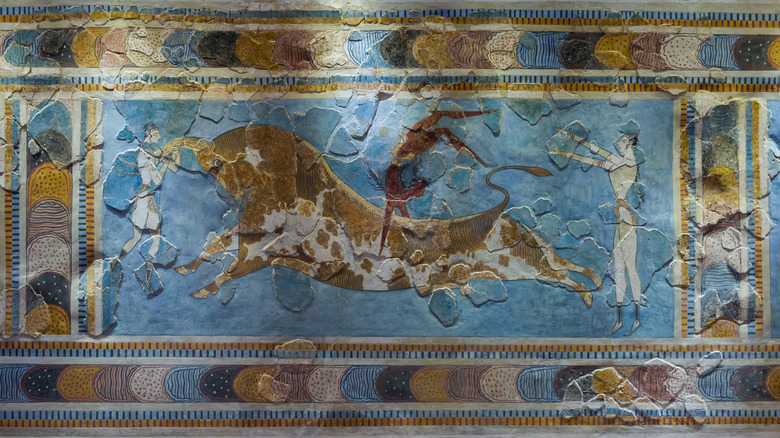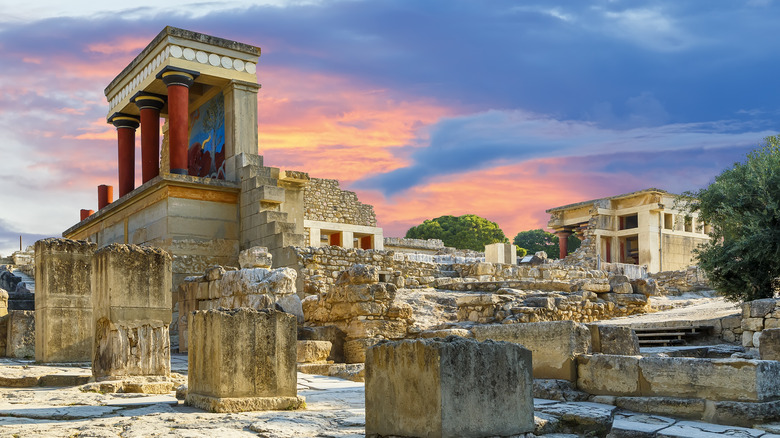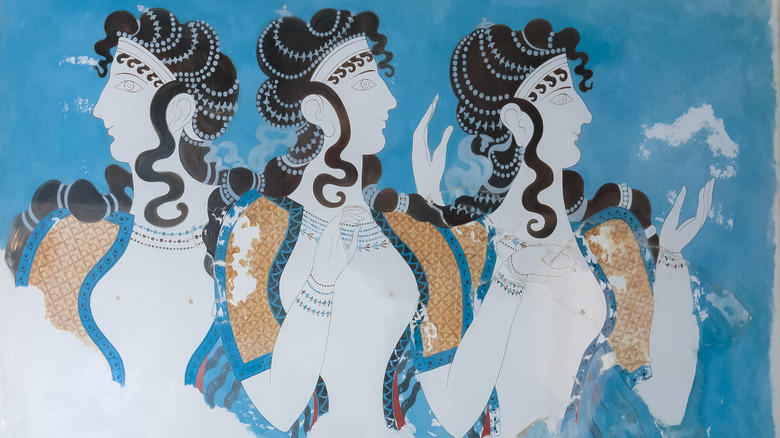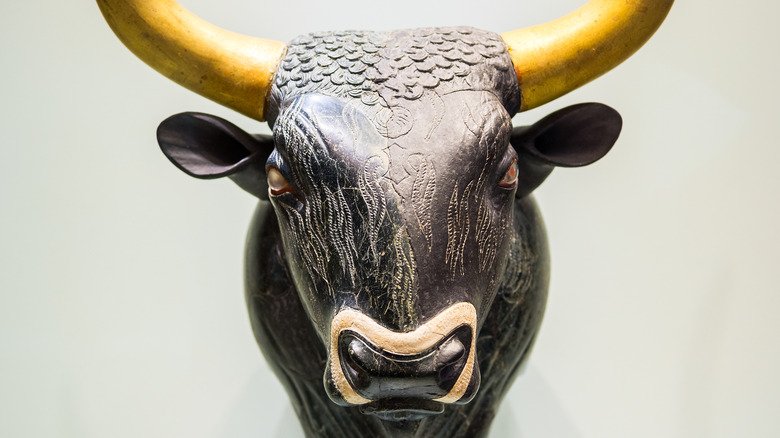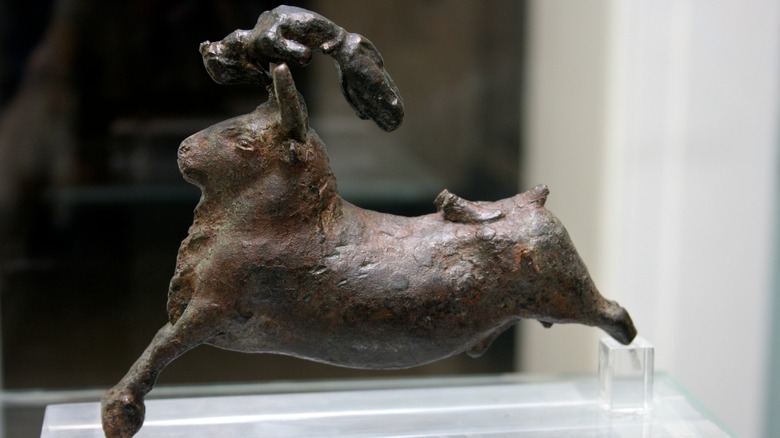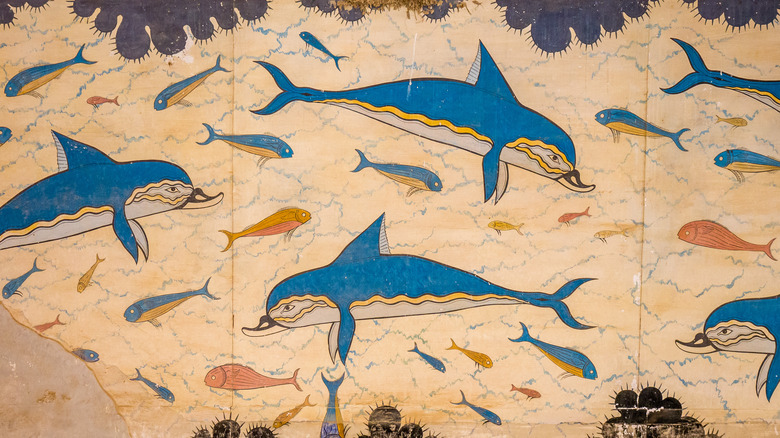The Bull-Leaping Women Of Ancient Minoan Greece
Ancient Minoa has always ignited the imagination, going all the way back to the familiar Greek tale of the Minotaur and the Labyrinth. The man-bodied, literally bull-headed Minotaur — named after his step-father King Minos, after whom Minoan civilization also gets its name — was trapped in a massive Labyrinth built by master inventor Daedalus. As National Geographic continues, nearby Athens sent 14 youths as tribute to the Minotaur every nine years. They were tossed in the Labyrinth and roamed its halls until the Minotaur found and devoured them. Eventually, the hero Theseus infiltrated the Labyrinth and killed the Minotaur with the help of Minos' own daughter, Ariadne.
It's an awesome story, awesome enough to intrigue the interconnected cities and cultures of the ancient world. But within its characters and scenes — King Minos, the bestial Minotaur, the Labyrinth, Daedalus, Theseus, Ariadne, etc. — are there any glimmers of historical fact? Most folks would say no, because it's all too mythical and fantastical. Then in 1900, as Minoan Crete outlines, British archaeologist Arthur Evans started excavating some ancient ruins on the Greek island of Crete. He discovered a vast, labyrinthian palace containing a fresco that, while it doesn't depict the precise story of the Minotaur, shows two women and a man vaulting over — battling, so to speak — a charging bull. The palace and art belong to ancient Minoa. They reveal the role of women in Minoan society, Minoa's curious preoccupation with bulls, and the connection between the two.
Reassembling ancient Minoa
When Arthur Evans began excavating Knossos in 1900, he had no idea that he was tapping a 5,000-year-old civilization connected to a familiar set of legends. Minoan society — this is our name for them, because we don't know what they called themselves — first emerged on the island of Crete around 3000 B.C.E., per the World History Encyclopedia. Their first palaces showed up 1,000 years later, and the height of their civilization endured for about 550 years until 1,450 B.C.E. when some unknown catastrophe sent their world into decline. By 1,100 B.C.E., Minoa was all but gone. At its height, Minoan civilization comprised a seafaring, autocratic empire that traded goods, art, and culture with Egypt, mainland Greece, Asia Minor, and more.
As National Geographic explains, it took 300 more years for familiar characters like King Minos, Theseus, and Ariadne to appear in written literature in "The Iliad." The Greek poet Sappho, whose works are mostly lost to us, first mentioned the Minotaur and his tribute of youths 200 years later in the 6th century B.C.E. Bit by bit, pieces of the story of Minoa accumulated from various sources over time. And bit by bit, the same basic motifs showed up again and again: people struggling with a bull-like creature, a maze-like palace, a great king, and a tyrannical blood ritual. Further excavations of Cretan Minoa revealed not only elements of these myths but also a singularly unique society where women played significant roles.
The prominence of Minoan women
It's safe to say that Minoan women played a prominent part in their society, or at least occupied a very different niche in comparison to other ancient cultures. In Greek states, for instance — at their height in the 5th to 4th centuries B.C.E., some 700 years after Minoa's decline (per Time Maps) — women maintained the house and took care of children. As the Metropolitan Museum of Art explains, women were expected to stay modest and covered in public, could attend speeches and socialize out of the home, and otherwise spent time in the women-only family gynaikon exercising or weaving clothing for the household. They also held a prominent place in religious rites, which makes sense considering potent Greek goddesses like Hera, Athena (after which the city of Athens got its name), Artemis (the twin sister of Apollo), etc.
Minoan women also seemingly played a huge role in religious ceremonies — as often-cited Minoan "Snake Goddess" statues depict, per the Brooklyn Museum — but the similarities end there. Because we still haven't deciphered Minoa's Linear A writing, as National Geographic describes, we have to learn about Minoan culture from their art. In art, Minoan women appear bare-chested in public, lavishly dressed, and adorned in jewelry. They look lively and giddy and pale-skinned according to the conventions of the time, as discussed by World History. And if the bull-leaping fresco at Knossos is representative of actual events, they also performed athletic events side-by-side with their male counterparts.
The horns of power
Now we come to an element of Minoan culture that doesn't seem to jive with — at least to the modern, anachronistic eye — a society of freewheeling, topless, happy-go-lucky, venerated women: Minoan bull art. Bull imagery is everywhere in ancient Minoa to an almost bizarre extent, as the Penn Museum describes. There are bulls on frescos on the walls in the palace at Knossos, like the aforementioned bull-leaping fresco, aka the "Toreador" fresco, per Greek Art & Archaeology. There are bull paintings at the entryways leading to the center of Knossos. There are rhyta (ritual vases) shaped like a bull's head where liquid pours from its mouth, like the one at the Heraklion Museum of Crete. There are bull rings, bull seals, bull figurines, portraits of bulls on sarcophagi, artwork of ceremonial bull bloodletting, and twin-bladed axes that might have represented a weapon used to behead bulls. On and on it goes.
In fact, there are so many depictions of bulls, bullheads, bullhorns, and so on that many think that the imagery was imposed by the upper class like political propaganda. Penn Museum quotes archaeologist Paul Rehak as saying, "So prominent is this bull imagery that one suspects that its dissemination reflects an institutionalized source, perhaps the elite who controlled the Knossos palace." In general, the bull may have symbolized the struggle with, and dangers of, the untamed natural world as opposed to the urban, controlled world of the palace at Knossos.
Leaping the bull
Now we come to the central, ultra-famous, and artistically gorgeous fresco that's helped garner so much interest in Minoa, Minoan culture, and the role of women in Minoan society: the bull-leaping "Toreador" fresco. As shown on Art History Resource, it depicts a charging bull and three figures — two women and a man. We know this because men in Minoan art were depicted with darker, reddish skin (presumably from working outdoors), and women were depicted with pale, white skin (presumably from working indoors, at least for the upper classes). Centuries later, mainland Greece adopted this artistic convention, per Greek Is.
As for the scene on the fresco, the man in the middle is shown flipping over the back of the bull. One woman to the right lifts up her arms, perhaps having already completed a similar leap. Another woman on the left grips the bull's horns as though preparing to leap like the other two. It's a fantastic and daring-if-true representation of what many have taken to be a sporting event. The Penn Museum even has a little diagram showing how bull leapers might have made the vault. This isn't the only depiction of bull leaping, either — there are figurines, as well, although it seems that by 1340 B.C.E. (about 100 years into Minoan civilization's decline, per World History Encyclopedia), the practice looks to have dwindled. It's believed that all such bull-leaping events happened in a particular courtyard, a kind of sporting ring, at the palace at Knossos.
Sporting event or cosmic drama?
So what are we to make of all this? Researchers have come to conclusions about the prominent role of women in Minoan society based on an aggregation of evidence: exuberant depictions of feminine beauty in art, all the "Snake Goddess" statues we described earlier, frescoes that, if taken non-symbolically, imply parity between men and women in an important cultural event, and so on. Some sites like The Syntopia have rather eagerly described ancient Minoa as a female-dominated matriarchy, but that's pushing available evidence into realms of speculation.
Taken hand-in-hand with Minoan bull imagery, ax depictions, and the seafaring, mercantile nature of Minoan society, it becomes harder to draw any specific conclusions about what was obviously a complex culture. Add to this the real-life labyrinth at Knossos on modern-day Crete; later Greek tales of tributes sent to Minoa as a sacrifice to a half-man, half-bull creature; and characters like Theseus, Ariadne, Daedalus, etc., and we can draft a compelling — but likely more-than-fictional — portrait of ancient Minoa. That is, at least until we crack the Minoan language, Linear A. Greek Reporter describes efforts underway to do just this.
At the very least, we know that such bull-leaping events might have happened because they still happen today. The French sport of course landaise involves athletes doing acrobatic leaps over charging bulls (watchable on YouTube). Whether such events started as pure sporting spectacle or were a recreation of some ancient cosmic drama, as Penn Museum describes, remains unknown.
